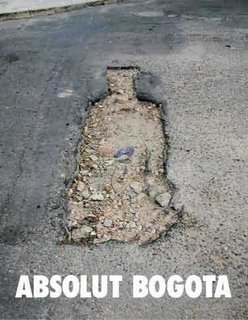
Now all the topics of discussion eventually become matters relating to mobility, specifically the Mobility Master Plan. Because as we all know about it has generated the greatest controversies of the present district administration, because this TransMilenio one hand, on the other the public transportation system, the state of the road network, public space, the bicycle path, freight transport, taxis, private transport and of course our newest mode of transport the rickshaw.
But all problems are going to one source, which make so much money that is required for the infrastructure that the mobility of the city of Bogota required, because the only thing that now has resources is Phase III of TransMilenio (Cra 7 th and 10 th and Calle 26), while the road network of the city continues to deteriorate to the point most critical, while the oversupply of public transport and individual continues to rise, while vehicles with more than 20 years of life of all kinds continue to ply our streets spewing into the environment each year an average of 10 tons of particulate pollutants , while the supply of transport miniaturized up to the use of media that until recently were those of small towns or municipalities as are the motorcycle taxi and rickshaw. All this without mentioning that no one has evaluated and quantified the impact of all this mess to which we must add the works of construction, repair, maintenance and who knows that most events that become daily traffic chaos throughout the city.
Well, then I will advance some of the measures that could be implemented for the Capital District may have more resources to the issue of mobility. At this point it should be noted that all this has already been invented in other cities in the world, so this is a bibliography.

· Road Pricing for Congestion Control: The cars are the vehicles 65.40% using the roads. By this figure is to establish a fee for driving on certain roads in the city at certain times in order to control congestion, thereby allowing their users to internalize the social costs arising from the use of private cars. Success Stories
road pricing have been in countries like Singapore, Norway, London and Santiago, Chile is in the process of development.
· Charge for parking in the procedure: The adoption of this measure has the great problem of insecurity, but in any case, all private car users assume the risk and leave their vehicles parked on road.
· Charge by Signage and traffic lights Service: The only contribution that citizens do to maintain and expand the traffic light system of the city is a small item that comes within the tax bearing vehicles, revenue for the Treasury. The STT should run more than 35 contracts per year regarding traffic light equivalent to more than 26,000 million.
· making and Goodwill: In this issue the administration did a great progress in recent days as the council approved the project which will get 2.1 billion dollars over the next 10 years. This however, creates the need for the management plan so coherent and rational investment of such resources in the short and medium term. Can not continue wasting resources on projects and works non-priority and essential to the population of Bogota, you can not afford to build "white elephants" as the road exchanger Calle 63 and Avenida bypass, connecting 80th Street The parking on the street 6, among many others.
· Charge to the Operators of Public Transportation System by the Use of Roads: The road network is a public service and a premium should therefore be considered charging for the use of it.
In conclusion is that the Administration should consider and study the following aspects:
· Awards for urban road construction
· Awards for the provision of public transport service in urban road operators
· Road charging for congestion control peaking
· Charge and restriction road parking in private
Inversion of construction and maintenance of underground parking, pedestrian areas to develop on the surface (you can develop commercial complexes in and around them)
· making and Goodwill by infrastructure
• Promotion of private participation in traffic light system of the city
· Improvement of public spaces with private participation (recreation, shopping, entertainment, etc.).


